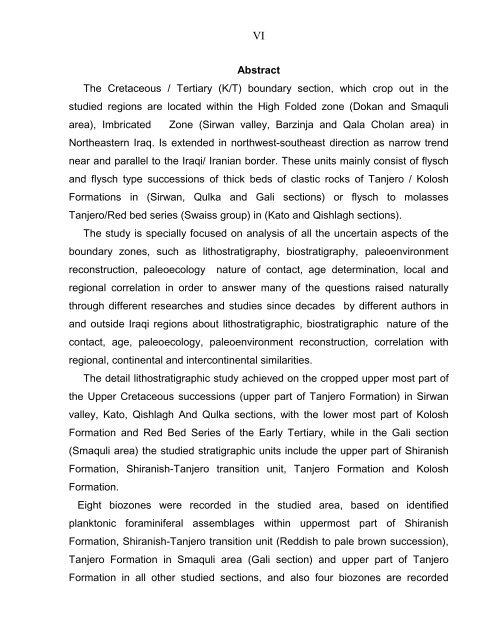biostratigraphy and paleoecology of cretaceous/tertiary boundary in ...
biostratigraphy and paleoecology of cretaceous/tertiary boundary in ...
biostratigraphy and paleoecology of cretaceous/tertiary boundary in ...
Create successful ePaper yourself
Turn your PDF publications into a flip-book with our unique Google optimized e-Paper software.
VI<br />
Abstract<br />
The Cretaceous / Tertiary (K/T) <strong>boundary</strong> section, which crop out <strong>in</strong> the<br />
studied regions are located with<strong>in</strong> the High Folded zone (Dokan <strong>and</strong> Smaquli<br />
area), Imbricated Zone (Sirwan valley, Barz<strong>in</strong>ja <strong>and</strong> Qala Cholan area) <strong>in</strong><br />
Northeastern Iraq. Is extended <strong>in</strong> northwest-southeast direction as narrow trend<br />
near <strong>and</strong> parallel to the Iraqi/ Iranian border. These units ma<strong>in</strong>ly consist <strong>of</strong> flysch<br />
<strong>and</strong> flysch type successions <strong>of</strong> thick beds <strong>of</strong> clastic rocks <strong>of</strong> Tanjero / Kolosh<br />
Formations <strong>in</strong> (Sirwan, Qulka <strong>and</strong> Gali sections) or flysch to molasses<br />
Tanjero/Red bed series (Swaiss group) <strong>in</strong> (Kato <strong>and</strong> Qishlagh sections).<br />
The study is specially focused on analysis <strong>of</strong> all the uncerta<strong>in</strong> aspects <strong>of</strong> the<br />
<strong>boundary</strong> zones, such as lithostratigraphy, <strong>biostratigraphy</strong>, paleoenvironment<br />
reconstruction, <strong>paleoecology</strong> nature <strong>of</strong> contact, age determ<strong>in</strong>ation, local <strong>and</strong><br />
regional correlation <strong>in</strong> order to answer many <strong>of</strong> the questions raised naturally<br />
through different researches <strong>and</strong> studies s<strong>in</strong>ce decades by different authors <strong>in</strong><br />
<strong>and</strong> outside Iraqi regions about lithostratigraphic, biostratigraphic nature <strong>of</strong> the<br />
contact, age, <strong>paleoecology</strong>, paleoenvironment reconstruction, correlation with<br />
regional, cont<strong>in</strong>ental <strong>and</strong> <strong>in</strong>tercont<strong>in</strong>ental similarities.<br />
The detail lithostratigraphic study achieved on the cropped upper most part <strong>of</strong><br />
the Upper Cretaceous successions (upper part <strong>of</strong> Tanjero Formation) <strong>in</strong> Sirwan<br />
valley, Kato, Qishlagh And Qulka sections, with the lower most part <strong>of</strong> Kolosh<br />
Formation <strong>and</strong> Red Bed Series <strong>of</strong> the Early Tertiary, while <strong>in</strong> the Gali section<br />
(Smaquli area) the studied stratigraphic units <strong>in</strong>clude the upper part <strong>of</strong> Shiranish<br />
Formation, Shiranish-Tanjero transition unit, Tanjero Formation <strong>and</strong> Kolosh<br />
Formation.<br />
Eight biozones were recorded <strong>in</strong> the studied area, based on identified<br />
planktonic foram<strong>in</strong>iferal assemblages with<strong>in</strong> uppermost part <strong>of</strong> Shiranish<br />
Formation, Shiranish-Tanjero transition unit (Reddish to pale brown succession),<br />
Tanjero Formation <strong>in</strong> Smaquli area (Gali section) <strong>and</strong> upper part <strong>of</strong> Tanjero<br />
Formation <strong>in</strong> all other studied sections, <strong>and</strong> also four biozones are recorded

















